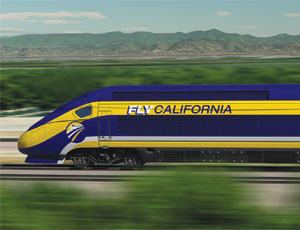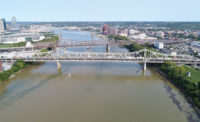The U.S. Dept. of Transportation has pumped another $2.5 billion into the high-speed-rail funding pipeline and is increasing the flow of actual obligations from its $8-billion first rail round. The moves are good news for the states that won grants and companies pursuing the work. However, whether the new Congress will approve another installment of

high-speed-rail (HSR) aid in 2011 remains an open question.
In announcing the winners of the $2.5-billion round-two competition on Oct. 28, DOT Secretary Ray LaHood said the money will help finance 54 projects in 23 states. Rail corridors received $2.15 billion, and individual projects across the country got $278.4 million.
Jeffrey Levy, president and CEO of Railworks Corp., New York City, says round two “was more focused on those projects with the best chances of success. I was afraid it would be a little money spread out everywhere.”
California, which envisions a $45-billion, 800-mile program, captured the largest sum—$901.6 million—which includes $715 million for a Central Valley segment: either Fresno-Bakersfield or Merced-Fresno. The state captured $2.3 billion in January, when the first HSR round’s winners were announced.
The state plans to draw on a $9.95-billion 2008 bond issue. California does not have the full $45 billion yet. But Maureen Hayes, a vice president with Parsons Corp., says, “They’re at a good place where they can start to build the basis of a system and then expand from there.”
Florida ranked second in round two, with $808 million, including $800 million for a planned Tampa-Orlando line. The new money follows a $1.25-billion round-one award for that line.
Florida DOT is preparing to seek bids in November for a $170-million “early works” package in the corridor.
Iowa got $230 million for track, signal and station work for planned new Iowa City-Chicago service. Michigan received $161 million, including $150 million to buy and upgrade 135 miles of rail line between Kalamazoo and Dearborn.
DOT got 132 applications from 32 states seeking $8.8 billion in round two, when $2.5 billion was available. In round one, total requests topped $55 billion.
The new round, funded by DOT's regular 2010 and 2009 appropriations. mandates that states put up at least 20% of a project’s cost. Round one, financed by the American Recovery and Reinvestment Act, did not require a non-federal match.
DOT’s Federal Railroad Administration has taken a while to turn the $8 billion in round-one HSR funds into actual obligations with signed grant agreements. But obligations have jumped to $1.6 billion, from about $585 million in August. Most of that total is due to a $708-million grant agreement announced on Oct. 31 for track, signaling, infrastructure and other work on the Milwaukee-Madison line in Wisconsin.
| CALIFORNIA | $ 901.6 |
|---|---|
| FLORIDA | $ 808.0 |
| IOWA | $ 230.4 |
| MICHIGAN | $ 161.1 |
| CONNECTICUT | $ 120.9 |
| VIRGINIA | $ 45.5 |
| MINNESOTA | $ 40.0 |
| MASSACHUSETTS | $ 32.5 |
| WASHINGTON | $ 31.0 |
| NEW YORK | $ 28.5 |
| WISCONSIN Milwaukee-Madison: track, signals, infrastructure | $ 707.7 |
|---|---|
| CALIFORNIA Transbay Transit Center: train box | $ 400.0 |
| CALIFORNIA Phase-one HSR program: prelim. eng., enviro. studies | $ 194.0 |
| FLORIDA Tampa-Orlando: program mgmt./prelim. eng. | $ 66.7 |
| VERMONT New England Central RR: route improvements | $ 50.0 |
| WISCONSIN Milwaukee-Madison: land bridges | $ 50.0 |
| WISCONSIN Madison-Watertown, Watertown-Milwaukee: design | $ 46.5 |
| MAINE Downeaster Portland North project | $ 35.0 |
| NORTH CAROLINA Charlotte-Raleigh: equip. procurement, rehab | $ 20.3 |
| NORTH CAROLINA Charlotte-Raleigh: stations, facilities, phase one | $ 16.9 |
David Carol, Parsons Brinckerhoff’s high-speed-rail point man, says, “It would be nice if the money came faster, but we’re, I think, pleased that the states and … the FRA are taking the time to make sure to have the projects in order and to ensure that in fact they can be implemented the way FRA and ultimately Congress expect them to be.”
“We are pleased with the pace,” adds FRA spokesman Rob Kulat. “We want to protect the taxpayers’ investment.”
Kulat notes that some projects already are under way, including work on San Francisco’s Transbay Terminal and station work in North Carolina, Portland, Ore., and San Jose, Calif.
As state and federal agencies gain experience with the new program, Kulat says obligations will pick up. “It’s going to be a much faster process now that there’s some history under our belts,” he says.
The rail program is particularly welcome for architect and engineering firms. Stephen Beard, HDR Engineering Inc. senior vice president and transit market sector director, says, “A lot of the other stimulus money and the big emphasis on shovel-ready kind of bypassed the A/E community. But with the high-speed-rail initiatives here, I think a lot of the money is going to go through the engineering firms.”
But it’s unclear whether there will be a round three next year. The House has passed a fiscal 2011 DOT spending bill including a further $1.4 billion for high-speed rail. The Senate Appropriations Committee cleared a 2011 DOT bill with a $1-billion HSR allocation, but there has been no final action yet on the DOT bill or other 2011 appropriations.
Peter Gertler, senior vice president and chairman of high-speed-rail services for HNTB, says, “There is a concern … down the road [about] a sustainable and a secure source of funding for high-speed rail beyond what has already been awarded.” HDR’s Beard says, “I think the next big thing is going to be [transportation] reauthorization and what that multi-year bill says about the high-speed-rail program.”



Post a comment to this article
Report Abusive Comment